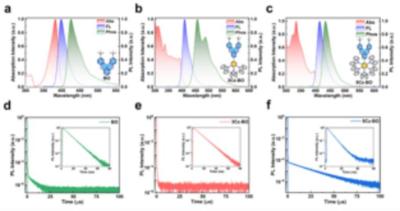Researchers from the University of Science and Technology of China (USTC), in collaboration with scientists from the University of Cambridge and Beijing Information Science and Technology University developed a novel blue OLED emitter design, based on 5Cz-BO molecules, that offers highly efficient emission with a narrow emission spectrum.
The new OLED emitters incorporate multiple carbazole donor groups into the multiple resonance (MR) type electron acceptor units. This design offers narrow-band short-range charge transfer excited states and it also reduced the energy level difference between the molecule’s singlet and triplet states.
The researchers say that structural relaxation in the excited state was effectively suppressed by the short-range charge transfer excited state, which results in a narrow-band deep blue light emission. The researchers also reduced the energy level difference between the molecule’s singlet and triplet states through the long-range charge transfer excited state, enhancing spin-orbit coupling and significantly increasing the molecule’s reverse intersystem crossing rate. Moreover, the steric hindrance effects induced by the introduction of multiple carbazole donor groups effectively prevented the aggregation of MR acceptor units, thus allowing the molecule to maintain narrow-band emission of deep blue light.
The researchers report that OLED devices based on the 5Cz-BO molecule achieved a maximum external quantum efficiency of 22.8% and a CIE value of (0.163, 0.046), closely matching the current BT.2020 blue light standard. Furthermore, the high reverse intersystem crossing rate of 5Cz-BO enabled its use as a sensitizer, resulting in a maximum external quantum efficiency of 33.1% for sensitized devices.


